December 2000 // Volume 38 // Number 6 // Commentary // 6COM2
Walking the Mile Barefoot
Abstract
A 15-year Extension professional finds the ultimate diversity training while working with the Mopan and K'ekchi' Mayan in the rainforest of Southern Belize. Needing to reach a culture so foreign to her, she reexamines diversity basics and, for the first, time understands the real charge of a change agent as well as the impact that the cultural lenses we wear have on our capacity to serve.
Diversity - A Critical Issue
Serving a broad array of ethnicities is a high priority at Rutgers Cooperative Extension in New Jersey. It has been an important aspect of my tenure with Rutgers Cooperative Extension to not only conceptualize diversity, but to also develop and implement programs that reach a wide spectrum of clientele.
I certainly thought that I was acting from a well-developed knowledge base concerning "reaching and teaching" diverse populations. I also thought that, after 15 years of experience, I understood the core of addressing diversity. That is, I thought that until I had spent just 1 month out of the year I had arranged as a sabbatical in the remote Toledo District of Belize.
Are Personal Experiences Valuable?
Before positioning fingertips on keyboard to write this piece, I reflected on the potential benefits others could gain from it. Would my experience be valuable to a Family and Consumer Sciences Educator in Connecticut, a 4-H Agent in California, an Agricultural Agent in Ohio? Can the lessons in diversity learned by one professional be applicable to another?
The answer, I concluded, was both yes and no. Submersion into another culture provides a perspective that, in some ways, is difficult to transfer. There is an esoteric "knowing" that just arrives when one engages in daily living in a foreign culture on a regular basis. However, as an addendum to all the diversity in-services and training manuals Extension professionals receive, I believe that several key points gained from my experience are transferable.
Hands-On Diversity Training
The Mopan and K'ekchi' Mayans of Southern Belize in Central America offer a wonderful hands-on diversity training, if one is willing to learn. To establish a relationship with the Mayans, one has to understand their culture. To the industrialized world, their lifestyle could be misunderstood as anything from quaint to primitive.
One of the first rules we've all learned through diversity training is to increase our knowledge of a clientele's culture. This part of the diversity equation was relatively easy. I accomplished my academic update by absorbing information from the only two books in existence regarding the contemporary socioeconomic conditions of the Maya of Southern Belize.
Rule number two, to "reach clientele where they are" culturally, educationally, and geographically, proved to be quite a challenge. I can speak from experience that it is one thing to work from a position of academic understanding regarding cultural values and practices foreign to one's own. It is another issue to actually move a programmatic initiative forward that truly reaches people.
Diversity rule number three, "provide [educational] opportunities that are determined by the target population," was not as much of an issue. Village leaders and the Belizean Minister of Rural Development and Culture, a Mayan himself, had expressed a need for the program to be developed. I was there upon the invitation of the Maya culture's stakeholders. Not surprisingly, however, the establishment of trust on the grass-roots level needed attention.
The Long Mile
Establishing trust wasn't as easy as "walking a mile in their shoes," where one ostensibly comes to understand a person or a population group. Both in reality and figuratively speaking, I walked the mile. In fact, I walked the mile barefoot, because most of the village women do not wear shoes. Some level of acceptance developed from my willingness to experience their culture, but mostly villagers found my desire to engage in their lifestyle peculiar.
I came to realize that I will never totally gain the cultural orientation of a Mayan woman, just as I will never truly understand the cultural orientation of an elderly Hispanic woman who attends my Extension classes in the United States. While I am a female, I am not Mayan, Hispanic, or elderly.
I can only make it a point to always engage individuals from diverse populations in the nuts and bolts of planning, implementing, and evaluating initiatives. Of course, I had recruited culturally diverse populations for all aspects of Extension programming in the past. But this experience reinforced my resolve to ask, and ask again, during all stages of programming, "Is this direction of programming suiting your needs?".
We may believe we have the research-based answer; however, long-term behavior change will never come about unless we work with the culture instead of trying to change it. I found that coming from a mindset of "I have the answer" is not only pompous, it is pointless. My experiences have given me a deeper and more profound understanding of the term "change agent."
My New Glasses
One of my greatest lessons was that it requires hard work and dedication to begin to understand another culture. It requires more than a half dozen in-services and the best of intentions to meet the needs of a diverse population. It requires the willingness to take off the spectacles through which each of us sees the world and risk trying on other pairs.
The spectacles we wear (mine ground by the effects of a university education, by being a Caucasian female member of the baby boomer generation, and by living in the North Eastern United States), hinder our sight as we try to connect with those who do not share our outlook. It requires concentration and constant attention to metaphorically take off one's spectacles and see clearly through another's.
It is far easier to do the work academically, to increase one's knowledge base about how and why others act different from us through texts and in-services. For academicians, understanding on this sociological level comes easy, too easy. To fight the urge to continue to look through glass ground only by our own personal or cultural experience is a high-maintenance activity.
I will give an example. Given my personal beliefs and life experiences, I would have never thought I would choose to try on the spectacles of an older Mayan man from one of the more remote villages. He sees through glasses that I previously could neither understand nor empathize with. For example:
- He sees that there is relatively little reason that children should go to school.
- He sees that he is the unquestioned authority of the household and that only males can hold leadership positions the village.
- He sees that domestic abuse is acceptable.
To try on his spectacles means to understand his cultural perspective. Granted, this is an exceptional example. Extension professionals are not challenged on a daily basis to look through the lens of an individual or a group that holds cultural norms so different from their own.
But taking the time to engage in the "spectacle trade" activity, to understand another's beliefs system and lifestyle norms, is the point. To move from studying the list of a population group's cultural ways that was handed out at an in-service or is part of a textbook we purchased is the point. To take the responsibility and, as previously noted, the risk to internalize why and how those cultural norm manifest in the behavior of a group or an individual is the point.
In the fast-paced world of being an Extension professional, with programs piled high and deadlines for reports even higher, how often did I really take the time to remove my spectacles prior to this experience? How often do you?
Understanding Through Pictures
The Mopan and K'ekchi' Mayan culture is outside the paradigm of American life. To emphasize the need to and potential challenge of taking off one's spectacles due to vast cultural differences, I provide some pictures.
Infrastructure, Community Living, Farming
San Vicente Village (Figure 1) is located on the Belizean/Guatemalan border. As in most villages in the area, there is no electricity or running water. Women wash their clothes and bath their children in the stream. Chickens and pigs roam free throughout the village. Villages are organized in a communal system. Group activities, such as a fajinia (cleaning of the village) are practiced on a regular basis. The alcalde (leader), however, decides where families will live and milpas (farms) will be placed.
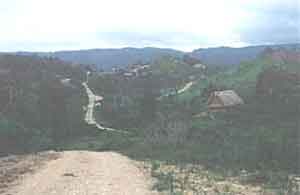
Figure 1.
The agricultural production method of slash-and-burn is used. Basic crop rotation is not always practiced. Figure 2 depicts harvesting rice with a sickle at Silver Creek Village.
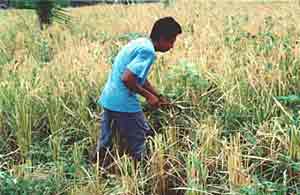
Figure 2.
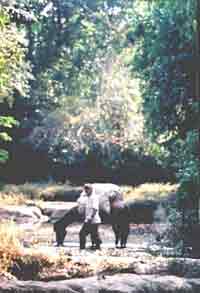
Figure 3.
Social Constructs Regarding Women, Family Planning
What American's refer to as the "children having children epidemic" is a cultural norm for young Mayan women. By age 14 to 16, young women are engaged by their parents to acceptable young men. Elder females in the village did not even meet their husbands-to-be until their wedding day. Females are not provided with family planning information by their elders. Figure 4 shows a K'ekchi' family at home.
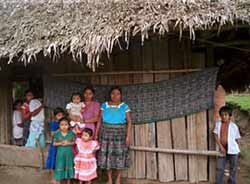
Figure 4.
Diet and Meal Preparation
Corn is the primary dietary mainstay for Mayans. The Food Guide Pyramid is not part of their understanding, nor is it possible given the lack of vegetables for part of the year. Malnutrition is widespread.
Women spend a large part of their day preparing corn tortillas, made fresh up to three times a day. In Figure 5 I am being taught how to take dry corn off the cob.
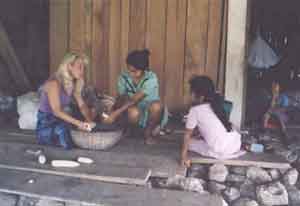
Figure 5.
The Elderly and Children
There is no such thing as "retirement." Elders work until they are too frail to perform their daily duties. Bush doctors provide the main medical interventions for village elders. Figure 6 (Eric Leupold, Leupold Photography) shows a village elder in the Deer Dance festival, a cultural/religious ceremony.
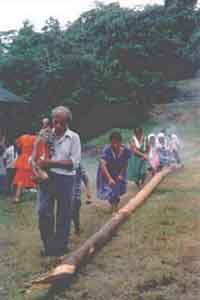
Figure 6.
Children attend school in their village through what is comparable to 6th grade. While there is a high school (comparable to 7 - 10th grades) located in Punta Gorda, the only town of significance in the Toledo District, few attend due to cost and transportation issues. There is no time for personal development and educational programs such as 4-H. Children are given household or farm responsibilities as soon as they are able. Figure 7 shows children rinsing corn in the stream.
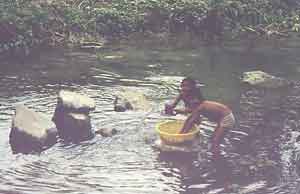
Figure 7.
Translating the Experience for the Future
Work with the Mopan and K'ekchi' Mayans was a personal wake-up call. My experience was an extreme example of an opportunity to provide service to a diverse population. But I was fortunate to be engulfed by their culture, where there were no other programming demands or deadlines to steal my attention. In addition to walking the mile barefoot and looking through another's spectacles, I was able to invest the time to contemplate and utilize the material from all of those in-services.
I looked for ways to make it work. I did far more listening than talking until I was sure I had an understanding of my clientele. I checked with key representatives within the Mopan and K'ekchi' villages to make sure I was not operating by stereotypes or disturbing cultural norms.
Today, the payoff is evident. The Mayan Elder Cultural Project is moving forward with ease, and I will resume my Extension responsibilities in the United States with more resolve to reach underserved populations and a little more confidence in my ability to do so.
